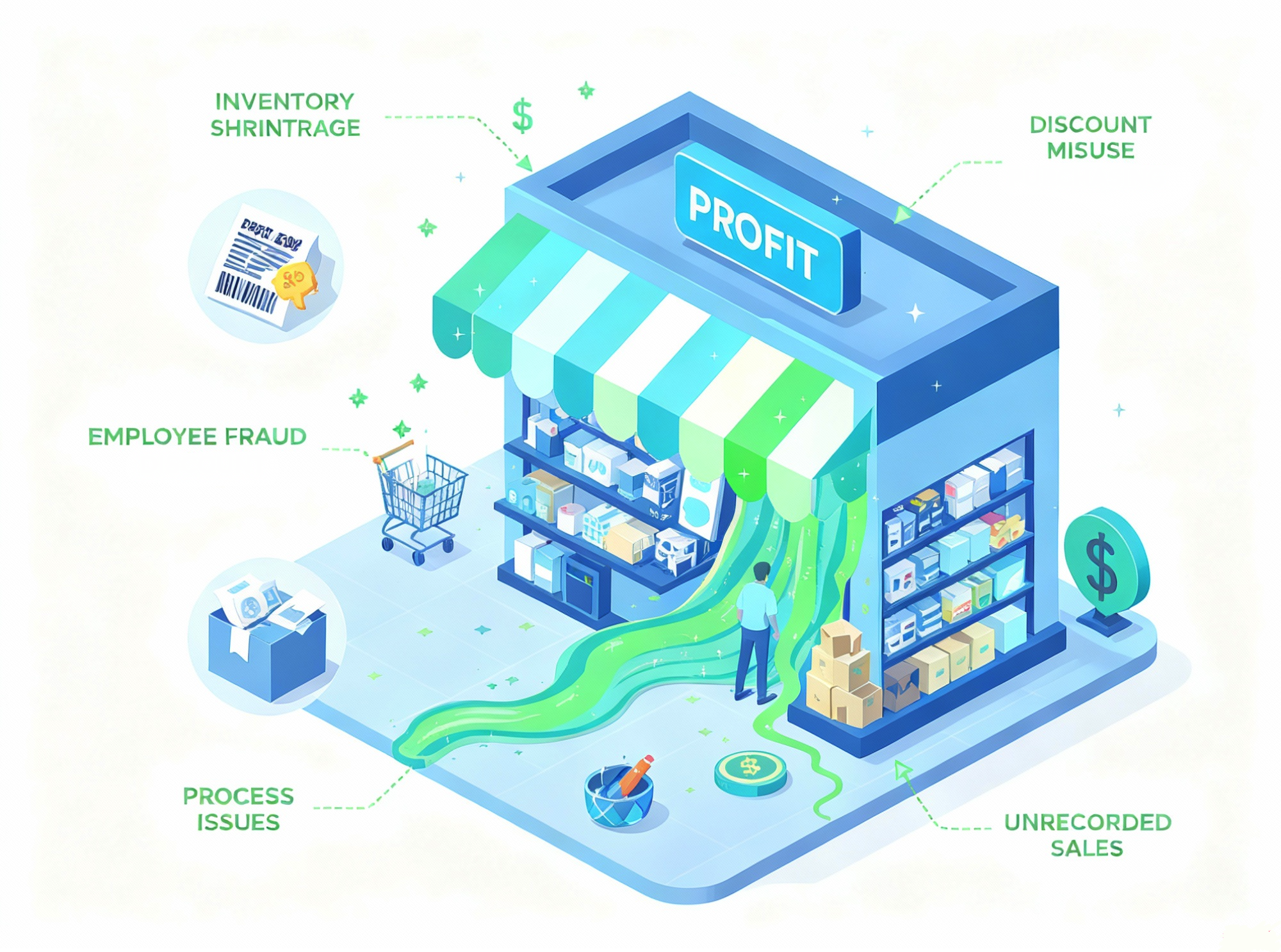Stop Profit Leaks: How a Smart POS Can Protect Every Dollar You Earn

Have you ever looked at your monthly profit and wondered, “Where did all the money go?” You increased footfall. You ran promotions. You hired good staff. Yet your margins barely budged. If that sounds familiar, you're not alone. Many retail and F&B businesses are bleeding small dollars every day — through silent leaks in operations — without realizing it. But the good news is: the right smart POS can act like a plumber, sealing those leaks and restoring your bottom line.
In this guide, we’ll walk you through:
- What “leaking profits” really means
- The six major leak paths in a retail / F&B business
- How a smart POS can help you stop leaking profits
- Best practices, controls & checklist
- How to choose a smart POS to prevent profit leakage
Let’s dive in.
What Is “Profit Leakage” — Not Just Theft
Before we talk about solutions, we must define the problem clearly.
Profit leakage refers to the erosion of profit margins through various hidden or uncontrolled channels, such as:
- Inventory shrinkage (theft, damage, spoilage)
- Employee fraud / POS manipulation (voids, overrides, returns)
- Discount / promotion leakage (uncontrolled discounts, stacking, misapplication)
- Process waste (mistakes, mis-routing, duplicate entries, manual adjustments)
- Poor procurement / over-ordering or maverick spend
- Incomplete revenue capture (sales bypassing system, “off-record” transactions)
In accounting terms, this is akin to margin leakage — the difference between gross margin on paper and the real margin after hidden costs.
Because many of these leaks are incremental and happen daily, they often go unnoticed until they add up to serious damage.
The Six Major Leak Paths (And How They Manifest)

Below is a breakdown of where profits typically leak in retail / F&B operations:
* These are indicative figures/estimates based on various industry-wide researches. The exact figures for your business may differ.
Each of these sinks profit quietly. The trick is to detect and plug them before they cascade.
How Your POS Can Help Control Profit Leaks
A modern smart POS (not just a cash register) has built-in features and integration capabilities that make profit leak prevention for your business feasible and scalable.
Here’s how a smart POS addresses each leak path:
a) Inventory shrinkage & stock discrepancies
- Real-time inventory tracking / sync: Inventory levels adjust instantly upon sales, returns, transfers. If the book says 10 units but actual is 8, alerts are triggered.
- Cycle count / audit modules: Frequent, automated spot checks help detect discrepancies early.
- AI / anomaly detection: Identify patterns such as repeated shrinkage in certain SKUs or locations.
- Barcode / RFID / QR tracking (for high-value SKUs) to trace movement.
- Expiration / batch tracking (especially in F&B, pharmacy) to reduce spoilage / waste.
b) Employee fraud / POS manipulation
- Role-based permissions / restrictions: Only managers can authorize overrides, refunds, price changes.
- Audit trails / logs: Every action is logged (who, when, where). Unusual refund volumes or voids show up on dashboards.
- Alerts / rules engine: Create rules like “if employee issues > 5 refunds in an hour, alert manager.”
- Reduced cash handling / push digital payments: Cash is harder to trace; digital payments provide built-in trace.
- Daily cash reconciliation / POS-end-of-day balancing: Compare expected vs actual cash; mismatches flagged instantly.
c) Discount / promotion leakage
- Controlled discount templates / policies: Predefine what discounts are allowed (percentage, product, time) and who can apply them.
- Auto validation / approval workflows: Discounts beyond thresholds require manager override.
- Promo stacking rules & exclusivity enforcement: Prevent misuse of multiple overlapping offers.
- Analytics on discount ROI: See how many discounts didn’t generate incremental sales but eroded margin.
d) Process / operational waste
- Automation & standard workflows: Reduce manual keying, copy-paste, data transfer between systems.
- Integrated modules: POS + inventory + accounting + CRM, rather than siloed tools.
- Template, presets & defaults: Reduce human error in repetitive tasks.
- Data validation / confirmations: Warnings if values deviate (e.g. negative stock, duplicate order).
e) Procurement / purchasing leakage
While purchasing is upstream of POS, modern POS suites often integrate with procurement / purchase order modules:
- Approval workflows for purchase orders
- Vendor catalogs / product master controls (only allow certain SKUs)
- Budget / spend limits per store / department
- Matching of purchase orders, receipts, and invoices to detect mismatches
f) Unrecorded / off-system sales
- Offline POS + auto sync: Even when the network is down, the POS captures sales and syncs when back online.
- Mandatory sales entry enforcement: System does not allow “freebies / freebies override” without log/approval.
- Integration with other sales channels: Ensure omnichannel sync so no channel is a leak point (e.g. e-commerce, kiosk, app).
Best Practices & Controls Checklist to Prevent Profit Leaks

Implementing a smart POS is just step one towards stopping profit leaks. To maximize effect, you need controls, governance, and continuous monitoring. Here’s a practical checklist:
- Baseline audit & gap analysis
- Perform a profit-leak audit: run historical variance analysis (inventory vs sales)
- Identify your highest-leak categories / outlets
- Define your control rules
- Permissions matrix (who can override, refund, discount)
- Thresholds (max discount %, max refunds per day)
- Procurement approval paths
- Train staff & set accountability
- Educate frontline staff on controls (why limits exist)
- Make each staff accountable (tie anomalies to performance)
- Use dashboards to show “scorecards”
- Set alerting & monitoring
- Build custom alerts (refund volume, negative stock, high variance)
- Weekly exception reports sent to managers
- Dashboard with trending leak metrics
- Conduct periodic audits / spot checks
- Surprise inventory / cash audits
- Compare POS logs to surveillance / cameras
- Root cause investigations
- Iterate & refine
- Review alerts / false positives
- Adjust thresholds, rules as you collect data
- Use anomaly detection / ML (if supported)
- Choose the right system
- Ensure your POS provider supports all the features above
- Open APIs / integrations to accounting, ERP, security systems
- Vendor support, customization, reliability
Choosing / Evaluating a Smart POS to Stop Profit Leaks
When evaluating a POS (or upgrading), here’s a comparative feature checklist (and what to ask vendors):
Apart from checking for these features, ask for case studies or client references where leak prevention was a primary benefit—not just a convenience add-on. This helps you understand how the POS performs in real-world business environments.
Before making your choice, it also helps to see how these capabilities come together in practice. A truly smart POS doesn’t just tick boxes on a checklist—it turns those features into daily visibility, faster decisions, and measurable savings.
That’s where systems like OneHubPOS stand out. A POS system should do more than record sales — it should protect them. Built with profit control in mind, OneHubPOS brings together real-time tracking, intelligent alerts, and airtight integrations across payments, inventory, and accounting. Every sale, refund, and report stays perfectly in sync, helping you close gaps you didn’t even know existed and keeping your profits where they belong.
💡 See how OneHubPOS can help you stop profit leaks before they start. Book your free 30-minute demo to see it in action.
Frequently Asked Questions
A smart POS gives you real-time visibility into every sale, refund, and stock movement. By setting permissions, alerts, and automated checks, it helps you catch inconsistencies like unauthorized discounts, cash mismatches, or inventory losses before they hurt your margins. Essentially, it acts as a control tower for your operations, keeping your profits from slipping through unnoticed gaps.
The biggest culprits are usually inventory shrinkage, unauthorized refunds, discount misuse, process errors, and unrecorded cash sales. Many of these leaks happen silently and repeatedly. A modern POS helps detect and prevent them through strong audit trails, real-time reports, and role-based controls that make every action traceable.
Yes. Even small stores can lose thousands each year to unnoticed errors or inefficiencies. A smart POS automates checks that would otherwise require manual oversight — saving both time and money. Many modern systems, including OneHubPOS, are modular and affordable, so you only pay for the features you actually need.
Most businesses start noticing improvements within a few weeks — fewer refund errors, more accurate stock counts, and faster reconciliations. Measurable profit recovery often appears within 2–3 months, especially once alerts and reports are tuned to your store’s workflow.
While no system can eliminate fraud entirely, a good POS dramatically reduces the opportunity for it. Features like role-based access, manager approvals for refunds, and detailed activity logs make it much harder for manipulation to go unnoticed. When employees know the system records every action, fraud attempts typically drop on their own.
Focus on features that give you visibility and accountability — real-time analytics, inventory sync, refund alerts, and clear audit trails. Also ensure the POS integrates with your accounting, payment, and inventory systems to close data gaps. Reliability and support matter too; a POS that’s down often can create new leaks instead of preventing them.
Rajat is a growth marketing professional with a passion for creating content that drives engagement and measurable results. He specializes in turning insights into clear, actionable stories that help brands scale.


